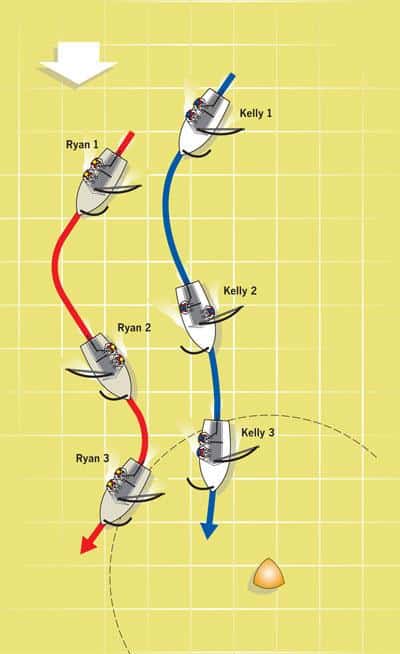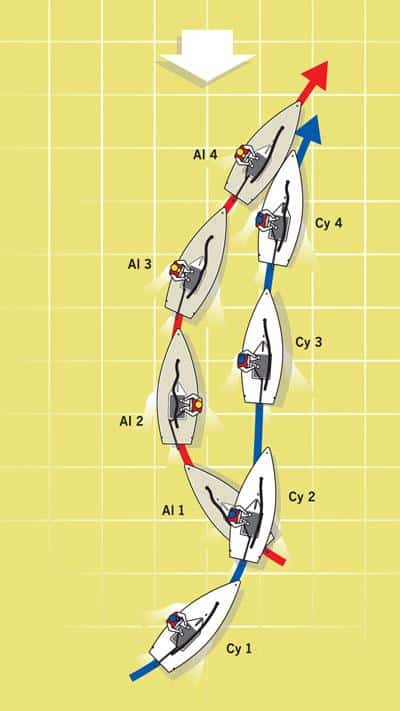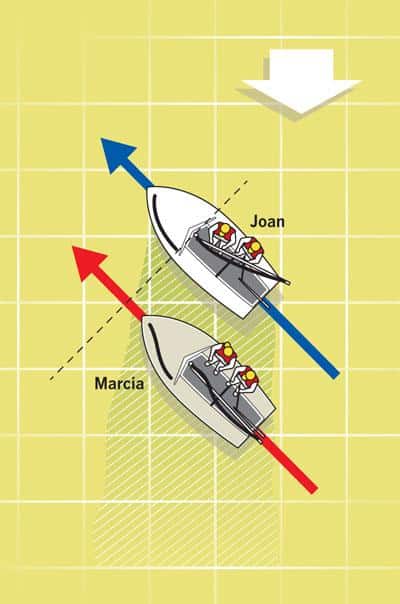
The “Patrick” Super Low
Skill Level: Champion
Former Silver Panda sailor Patrick Hogan and crew Carlos Lenz surprised opponents all the time using this move.
The scenario: Kelly and Ryan are running downwind on starboard with both sails to leeward at position 1. As the clear astern boat, Kelly is closing the distance to Ryan. Ryan will likely head up in order to keep his air clear and maintain the lead. At the same time, he wants to protect the right-hand side of the run (looking upwind) to preserve his starboard advantage at the leeward mark; Ryan is eager to jibe to port once a serious threat is detected.
How to execute:
1. Patience is required. Kelly sails “super low” by the lee with the wind flowing from leech to luff and filling the jib, possibly taking the vang off too. She’s looking to create some separation to the inside and make Ryan nervous. When Ryan jibes to defend the starboard advantage at position 2, Kelly gets him on starboard.
2. Timing is everything. Kelly keeps an eye on Ryan; when he turns forward to take stock of the rest of the race, she breaks low to a wing while heeling the boat to windward. She has to sail as far by the lee as possible to create the illusion that she’s going to jibe. Ryan will likely go with Kelly in the interest of protecting his starboard advantage. This time, she will catch him more by surprise on starboard.

The Slam Punk
Skill Level: Varsity
This is the anti-Slam Dunk, where you punk the dunker. This is Call D4 in the Call Book for Team Racing, but it has to go in your arsenal of moves.
The scenario: Going up the beat, Cy is on port tack and in a position to closely duck Al on starboard in position 1. Cy suspects Al will tack on him.
How to execute: As Al turns head-to-wind to tack in position 2, Cy sails above close-hauled and heels to windward. Once Al passes head-to-wind, at position 3, he must keep clear of Cy. Essentially, Cy takes away Al’s room to complete his tack. Al will likely (a) foul, (b) execute a bad tack, where he can no longer control Cy, or (c) realize that he won’t be able to complete the tack and go back to starboard after two downspeed maneuvers. In almost all of the cases, Cy exits by putting his bow down and extending on port, now able to come back at Al later with starboard advantage. If you’re in Al’s position, anticipate that an opponent will do this to you; consider leebowing to maintain starboard advantage.

The Super Slow
Skill Level: Junior Varsity
The scenario: Two teams of two boats are on the last leg of the race; the team with the last place boat will lose. Joan is in first and needs to get her teammate out of last by slowing Marcia.
How to execute: Joan positions her boat directly to windward of Marcia with about two feet of separation. Joan pulls her boom to windward, creating a huge wind shadow from which it is hard for Marcia to escape. As the skipper, Joan must put the mainsheet and tiller in her aft hand and pull the boom as hard to weather as the conditions permit with her forward hand. In medium to heavy breeze, Joan’s crew must hike extra hard and use the jib for speed control. Joan can also help control her speed by letting the boom “breathe” to leeward to get going again.
Bonus Move for Crews: Anthony’s Jib-Sheet Crossover
In his 2001 Sailing World article, “Seven Speed Tips for Collegiate Dinghies,” Anthony Kotoun described the jib-sheet crossover. While this technique is helpful for fleet racing, it is really best suited for team racing.
The scenario: You round the windward offset on a windy day with an opponent not too far behind. You’re on a broad reach, trying to extend down the run. A puff brings your opponent within half a boatlength, and they try to pass on the high lane.
How to execute: As a crew, you normally go down to leeward when reaching and hold the working jib sheet around the outside of the shroud. If your opponent attacks high, you’ll be delayed a few seconds as you pull the slack out of the working jib sheet through the block to get to the windward rail, by which time your opponent will have rolled over you. With the jib sheet crossover, however, you trim from the leeward rail (outside the shrouds) with the lazy sheet and keep the would-be working sheet fairly tight through the block. As soon as your opponent attacks high, you instantly grab your preset working jib sheet from the block, hop up to the rail, and hike to keep your air clear.









